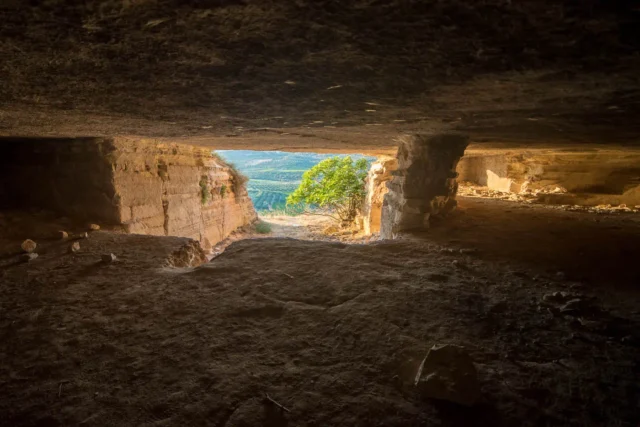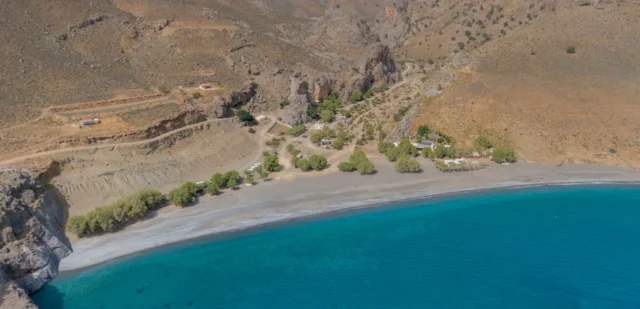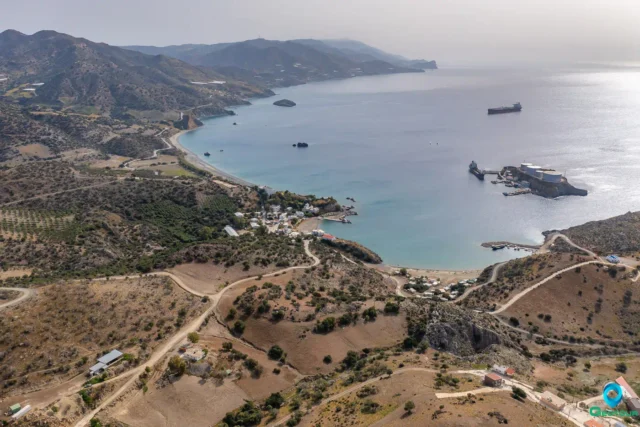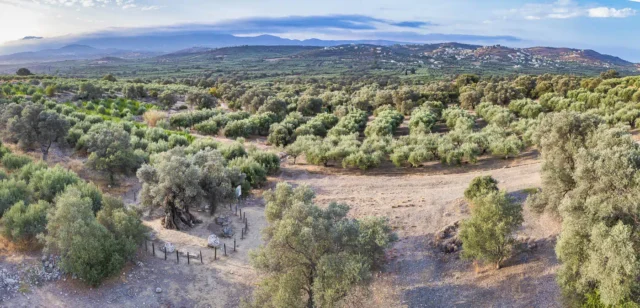748
listings found
Categories
Active filters:
Small Labyrinth cave
The Small Labyrinth Cave, or Labyrinthaki Cave, is an ancient 300-square-meter quarry located 50 kilometers south of Heraklion, between Plouti and Moroni, Crete. Used for stone in Minoan Phaistos, Agia Triada, and Roman Gortys, it features columns and labyrinthine passages. Distinguishing it from the larger Labyrinth Cave on the same hill, it has a depth of 120 meters and shares similar geological formations. Local tradition suggests secret passages connect the two caves, despite rockfall blockages. This site offers insights into ancient quarrying and Crete's historical architecture.
Koules in Magarikari
The Koules of Grammeni, also known as the Koules of Grigoria or Magarikari, is an Ottoman fortress in Crete, Greece. Built in the late 19th century during the Great Cretan Revolution (1866-1869), it was strategically positioned between the villages of Grigoria and Magarikari overlooking the Messara Plain. Measuring 25 meters by 11 meters, with 24 embrasures, it was used as a stronghold by the Ottomans to maintain control over the rebellious Cretan population. In May 1944, it provided refuge to the villagers of Magarikari during the German occupation. Today, the Koules of Grammeni stands as a well-preserved reminder of Crete's turbulent past and the island's enduring spirit.
Early Christian Basilika at Onithe
A significant Early Byzantine structure in Rethymno, Crete, dating to the late 5th and early 6th centuries AD. This three-aisled basilica, measuring approximately 36 x 17 meters, was built on a slope with stepped aisles separated by colonnades. Architectural features include a portico, narthex, a potential atrium, and an eastern semicircular apse with a synthronon. Flanking the sanctuary were pastophoria, likely a Prothesis and Diakonikon. Mosaic floors decorated the central aisle, sanctuary, and narthex.
Moni Koudouma
Koudoumas Monastery is one of the oldest monasteries on the southern coast of central Crete, Greece. It is situated at the exit of the Katarraktis gorge in the Asterousia Mountains, […]
Tsoutsouras
Located on Crete's S. coast (Heraklion), 63km S. of Heraklion town at the Mindris Gorge exit near the Asterousia Mountains. Site of ancient Inatos, Priansos' port. Features a ~2km sand/pebble beach with clear, calm, shallow waters, ideal for families, shaded by tamarisk trees. Organized with amenities like sunbeds, showers, and nearby tavernas. Local tradition attributes therapeutic qualities to the water. Accessible via a paved, winding mountain road. Nearby are Pera Tsoutsouras (shallow, sandy), Maridaki (pebble, isolated, gorge access), and Listis Beach (rocks). Offers a quiet, relaxing atmosphere.
Trypiti beach
Located on the southern coast of Crete's Heraklion prefecture within the Asterousia Mountains, approximately 57-73 km south of Heraklion city and 12 km east of Lendas. It sits at the exit of the Tripiti Gorge. The name relates to local geology and the Panagia Tripiti chapel cave. Access involves unpaved dirt tracks from Lendas or Vassiliki, often requiring a 4x4 vehicle, particularly the route through the narrow final gorge passage. The 400m beach features fine pebbles, clear, calm waters sheltered by Cape Fylakas, though it deepens quickly offshore. Tamarisk trees and cliffs offer shade. Despite difficult access, it's popular with locals and can be crowded. Basic tavernas are available, but no organized facilities exist. The area, part of Natura 2000, sees local caravan presence. Activities include swimming, snorkeling, hiking to nearby Minoan ruins of Papouri, and stargazing.
Agios Pavlos sand dunes
Also known as Alatsogremnos, is a long sandy beach with towering sand dunes, perfect for swimming, snorkeling, and enjoying stunning sunsets.
Trafoulas beach and gorge
Trafoulas Gorge: A Geological Masterpiece in the Asterousia Mountains Trafoulas Gorge is a breathtaking geological formation located southeast of the village of Krotos in the Asterousia Mountains. Hidden from the […]
Kaloi Limenes beach
Kaloi Limenes, in Heraklion, Crete, is a coastal settlement with a natural harbor. The area is known for its rugged beauty and proximity to Lentas and the ancient city of Lasaia. A small islet named "Apostolos Pavlos" is located in the harbor and a nearby church is dedicated to Apostle Paul. The name Kaloi Limenes appears in the Acts of the Apostles and is associated with Apostle Paul's journey. During the Venetian era, it was known for smuggling activities.
Ancient Eleutherna
The ancient city of Eleutherna in Crete, a significant center of power and culture from the Bronze Age to the Byzantine era with rich archaeological remains, including houses, public buildings, sanctuaries, and necropolises.
Gortyna archaeological site
Gortyna, located on Crete's Mesara Plain, was a major ancient city second only to Knossos. Inhabited since the Neolithic period (7000 BCE), it flourished during the Bronze Age under Minoan and Mycenaean civilizations. By the Archaic and Classical periods, Gortyna was a powerful city-state, sometimes allied with, sometimes rivaling, Knossos. In 67 BCE, Romans conquered Crete, making Gortyna capital of the province of Crete and Cyrenaica. The city thrived under Roman rule, with new infrastructure like the Praetorium, amphitheater, and Sanctuary of the Egyptian Gods.
A key discovery is the Gortyn code, the oldest known complete ancient Greek law, offering insights into 5th century BC social, economic, and legal structures. Gortyna embraced Christianity during the Byzantine era, evidenced by the Basilica of Saint Titus. The Arab conquest in the 9th century CE led to its decline. Today, Gortyna is a major archaeological site with ongoing excavations. Key sites include the Praetorium, Odeon (housing the Gortyn code inscription), amphitheater, Pythion Theater, Sanctuary of the Egyptian Gods, Basilica of Saint Titus, and Acropolis.
Festos (Phaistos)
Phaistos, a significant Minoan city in Crete, second in importance to Knossos, located in the Messara Plain. It dates back to 4000 BCE with a palace built in 1900-1700 BCE. The city was destroyed by an earthquake around 1700 BCE and rebuilt with a larger palace. Phaistos had connections with Knossos, Hagia Triada, and Gortyn. Important findings include the Phaistos Disk, Kamares Ware, and architectural remains. After a decline, Phaistos was reoccupied in the Hellenistic period (c. 323-67 BCE) until conquered by Gortyn.
Mana Elia, ancient olive tree
The Monumental Olive Tree, or “Mana Elia,” is a 2,800-year-old olive tree located in Kamilari, Crete. It has been designated a natural monument due to its size and historical significance. The tree has a base perimeter of 9.5 meters and its trunk is marked by age. The Kamilari Cultural Association has placed twelve large stones around the tree for protection. Eight of the stones are carved with the double axe symbol associated with the Minoan civilization. Mana Elia is near the Kamilari Tholos Tomb and the Minoan Palace of Phaistos. It is a “Thrombolia” variety olive, locally called “Hontrolia,” grafted onto a wild olive rootstock. This grafting technique ensures the tree’s continued health. Mana Elia is a popular tourist attraction and represents Crete’s history of olive cultivation. It is valued for its historical and cultural significance.
Tholos Tomb of Kamilari
The Tholos Tomb of Kamilari, located on a coastal hill near Phaistos in Crete, is the largest and most well-preserved Minoan tholos tomb. Constructed around 1900 BC, it offers valuable insights into Minoan funerary practices. The tomb's proximity to Agia Triada and Phaistos suggests a connection to the elites of these settlements. The Kamilari cemetery includes three tholos tombs, with Tholos A being the most preserved, featuring a circular chamber, external rooms, and an open-air courtyard. Tholos B and C are partially preserved, with Tholos C repurposed as a shrine dedicated to Demeter and Kore. A research project is underway to study the cemetery, including its stratigraphy, artifacts, and human remains. The project aims to understand the changing mortuary behavior and social choices of the communities who used the cemetery over centuries.























